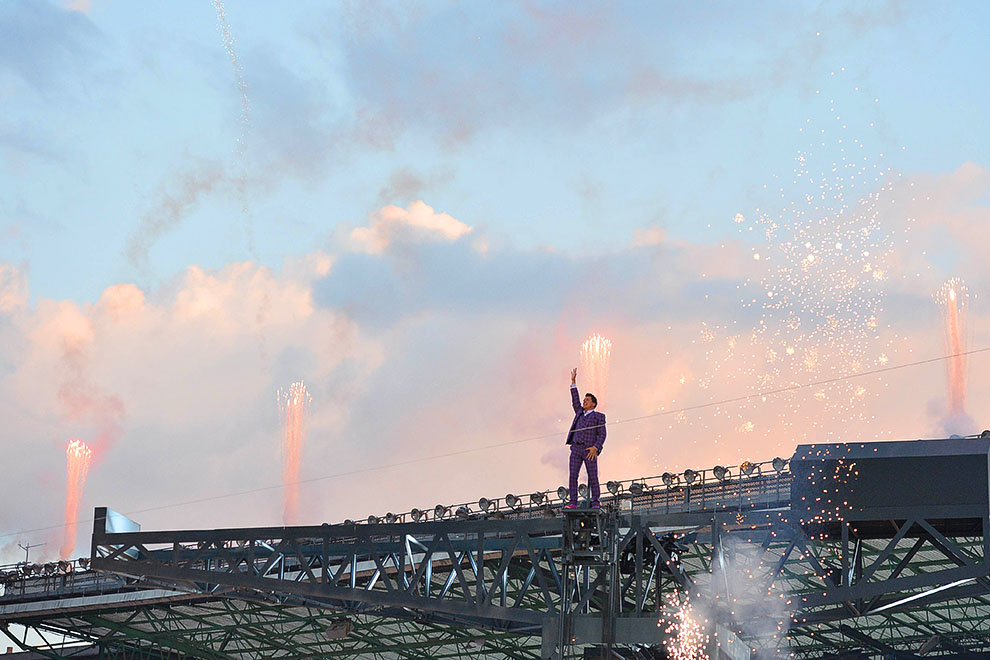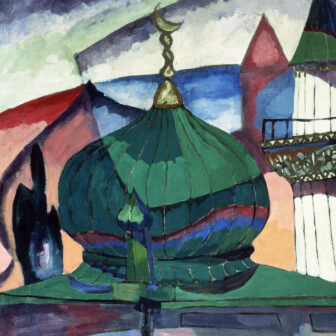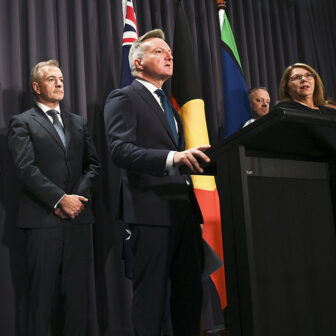No one ever called Glasgow the “second city of the Commonwealth.” The operative word was always “Empire,” even if the accolade, during the Victorian period when it took hold, was contested with Liverpool, that other great port city in England’s northwest. Two centuries on, visible interest in Glasgow’s role in Britain’s empire is mostly limited to exhibitions or the local-history trails that wind around Jamaica Street and the mansions of the “tobacco lords.” But Glasgow was always good at shedding old layers and adorning itself with new, and its hosting of the Commonwealth Games, launched with an exuberant opening ceremony on 23 July, shows it has kept the knack.
The gusto of its embrace is evident in the ubiquitous flags of the seventy-one competing states and territories, the advertising posters and information brochures, the climax of the worldwide “queen’s baton relay,” the spin-off conferences and art projects, the welcome from friendly guides (who, as in Sydney’s Olympics, can do so much to shape perceptions of an event and its home city.) The pre-tournament norovirus health scare, and controversy over Team Scotland’s garish uniform – more suitable for a Brigadoon theme park, say critics – provided newspapers with plenty of stories before the competition began. All this, plus the work invested in building or upgrading facilities since Glasgow was awarded the games in 2007, gives the organisers reason to hope that by the finale on 3 August, it will have done the best possible “brand awareness” job.
As for the legacy, measuring it will, as ever, keep researchers busy for years. The running cost, currently at £560 million, is a third over initial estimates but not excessive by the scandalous standards of recent big projects in Britain. There is visible investment in parts of Glasgow’s poorer east end where the events are taking place, such as Dalmarnock, Bridgeton and Rutherglen: fresh transport upgrades and links, construction work around the athletes’ village (which will be converted into 700 new homes). But a longer-term jobs boost in these areas, where call centres and retail outlets are the lead employment options, is at present still mist over the Clyde.
The sport and the legacy aside, of more immediate concern to many is the extraordinary political psychodrama that surrounds the games. When Scotland’s largest city outvoted Abuja to win the games, no one could have foreseen that they would be held seven weeks before a plebiscite on the country’s independence. As things turned out, the combination of location and timing adds a spicy ingredient to an already overheated meal, where every cryptic celebrity morsel – David Bowie’s “Scotland, stay with us,” J.K. Rowling’s “Death Eaterish” open letter, Billy Connolly’s “the Scots will get what they deserve” – is devoured in an instant by the referendum maw.
Clearly, a ten-day spectacle where Scottish and English athletes compete under “their own” flag (unlike in the Olympics, which is all Union Jack-ery), and where there are countless other sub-plots, is conducive to a feverish spasm or two. The Telegraph speculates that home crowds will boo the English, a suggestion pooh-poohed by the paper’s own columnist Allan Massie. Scotland’s minister in the London government, Alistair Carmichael (a Liberal Democrat), warns the leader of the Scottish National Party, or SNP, Alex Salmond, not to use the games as a campaign tool. (Salmond’s flourishing of a Saltire flag in Wimbledon’s royal box when Andy Murray won the men’s final in 2013 won him more ridicule than acclaim.) A pre-emptive call for dignity is a cannier flag for a politician to wave.
The refovirus, though, won’t be easily contained. Joan McAlpine, the SNP member of the Scottish parliament – last encountered rewaging the Great War on Scotland’s behalf – says the Commonwealth Games are “[not] just a sporting inspiration” but “a great example of cooperation between people who share some historic ties but are also proud of their distinctiveness and independence.” On the other side Tristram Hunt, a prolific historian who doubles as Labour’s education shadow minister, writes in the Sunday Times that of all Scotland’s cities “outward-looking, trading, multicultural Glasgow reveals the benefits of being in the UK.”
This drumbeating context of high stakes and potent symbolism may ensure the odd kerfuffle. Yet the Scottish public, polls say, will be unforgiving of any effort to exploit the games, not least for the disrespect to everyone involved it would entail. Glaswegians’ instinctive warmth and hospitality might prove the best prophylactic.
The Commonwealth Games are unlikely to swing a single vote. But Glasgow will find its own way to imprint itself on the occasion. In the run-up, many in Scotland’s largest city – at 600,000, a fifth more populous than the capital, its great rival Edinburgh, forty miles to the east – have been reflecting on how the event fits into its history.
One theme is the need to recall the substance of “second city of the Empire” rather than citing the phrase while forgetting its roots. The notion itself can be traced to 1825, though it gained currency from John K. McDowall’s A People’s History of Glasgow, published in 1899 when the city’s industrial prowess was approaching its zenith. John M. MacKenzie, leading historian of the cultures of imperialism, writes that it was “a sort of mantra of pride in place and achievement that elite Glaswegians clung to and successfully disseminated among other classes for more than a century.”
Empire went deep into the city’s life: its trading networks and business interests, architecture and civic institutions, its newspapers and entertainments, its class divides and ethnic components. In a fine essay, “‘The Second City of the Empire’: Glasgow – Imperial Municipality,” MacKenzie also notes C.A. Oakley’s argument in his 1946 book The Second City (“a truncated reference that everyone was expected to understand immediately”) that Glasgow held the informal title from 1800 until at least 1914, in the process holding off competition from Birmingham, Sydney, Montreal, Toronto and Calcutta.
But the reputational overlap with Liverpool also makes sense, for it reflects how similar the cities’ modern journey has been. Each experienced rapid growth to becoming mercantile hub and industrial powerhouse; each accumulated vast wealth founded on trade in slaves, sugar and tobacco, alongside great poverty; each received a huge inflow of rural migrants (Irish in both cases, Gaelic and Welsh from respective hinterlands, but also sailors-turned-settlers of black Caribbean and Chinese origin); each incubated many political ideologies, by turn Unionist and Liberal, radical and socialist. No wonder that a certain affinity between the people of the two cities arose, even as their masters vied for status in an imperial league table where, of course, London was the undisputed champion.
The legacy of that epic period was painful, both in the depressed inter-war years and again since the 1970s. Empire’s long withdrawing roar, and strategic failures to adapt, left multiple problems: loss of industry and skills, low investment, global competition, high unemployment, educational failings and poor health, all compounded by short-sighted (or worse) governance. In places like Glasgow and Liverpool, the memory of former grandeur – however hard actual conditions had been for many at its height – can make the sociologists’ “cycle of deprivation” seem all the more intolerable. In face of it, the only realistic option has been substantial adjustment (“regeneration,” the boosters would say) with the long-term aim of economic viability in a healthy social environment.
For such proud but diminished cities (Glasgow’s population, over a million in 1961, fell a third by 1991), this latest stage is strewn with rocks: akin to reversing in mid-ocean the great liners they were once famous for building. The story of regeneration is routinely told by the winners and flattened into an easy “before” and “after” marketing-speak that falsifies both. (I vividly recall a Glasgow friend looking back from the 1990s to the 1960s and saying of the urban fabric and public life of the city: “Things were neither so bad before, nor are they so good now.”) The wasteful projects, false trails, bad decisions, scandals and pork-barrel politics also need to be registered – and Glasgow has had many of those.
Amnesia is fuelled by other Glasgow impulses: make it new, build it big, show it off, knock it down and start again. A case in point was a plan to blow up five of the six remaining Red Road public housing tower blocks, also in Glasgow’s east end, as part of the Commonwealth Games’ opening spectacle. Built between 1964 and 1969, and the highest in Europe at the time, the flats were a symbol of that era’s municipal modernism, but had long suffered from neglect, disrepair, and abandonment. Many ex-residents, including asylum seekers, nonetheless saw the public demolition of their former homes as a sort of desecration. Their protest forced the whizz to be abandoned. The words “insensitive” and “trampling on our history” were much used, to a discordant murmur from a million of the city’s ghosts.
Ill-judged, yes, but the “blow-down” – announced as “an unforgettable statement of how Glasgow is confidently embracing the future and changing for the better” – also went with the grain of much of Glasgow’s history. The spirit of the planners and architects who smashed a maze of motorways through the city centre in the 1960s still rules. Along the way they pulverised the tenements of the huge, working-class, multifarious Gorbals district – once routinely seen as “notorious,” now as a ripe source of fond if standardised memoir. (So powerful is this imaginative shift that it reframes even postwar social-realist depictions, such as A.L. Lloyd and Bert Hardy’s shaping Picture Post feature, published in January 1948, or David MacKane’s film The Gorbals Story, released in 1950, which adapted Robert McLeish’s 1946 play.) In Glasgow even more than elsewhere in Britain, it can seem (to adapt August Bebel) that regeneration is the socialism of the victors, nostalgia the socialism of the losers, and that both are wrong answers to a real conundrum.
If Red Road was one case study in how Glasgow works, another was visible in its council leader’s decision to countermand the result of an open architectural competition for the redesign of its traduced civic heart, George Square, in time for the games. This had been won in January 2013 by John McAslan, a son of Dunoon in the Clyde estuary, who found early inspiration in the “implacable, superfunctional forms of American nuclear submarines” stationed there. His history-respecting modernism is embodied in his company’s majestic renovation of London’s Kings Cross railway station.
McAslan brought the same vision-in-place approach to George Square, but the judges’ verdict was instantly overturned by Gordon Matheson, the Labour chief of Glasgow’s city council, an act that prompted a formal complaint from the Royal Incorporation of Architects in Scotland and a police investigation. Both ran aground. On the eve of the games, Matheson warns against Scottish independence in the Labour-loyal Daily Record and boasts, “We were the second city of the empire and are set to become the first city of the Commonwealth.”
The cycles of destruction and remaking of Glasgow’s civic landscape mirror the great changes in its economic life, which today make public services, finance, tourism, the creative sector and broadcasting more important than industry as a source of employment and wealth. (Shipbuilding and engineering do survive on the Clyde, if much reduced, and its industrial past is at the core of the city’s identity.) The city, like every other in Britain, also floats on a sea of intoxication – the sociologist Dick Hobbs calls it the “alcohol economy” or “night-time economy” – whose social and personal costs are notably high. A brave psycho-social assessment, Carol Craig’s The Tears that Made the Clyde: Well-Being in Glasgow, connects people’s problems of ill health, poverty, addiction and male aggression to the city’s industrial experience.
The milestones of regeneration have often been instances of “cultural urbanism”: the opening of the Burrell collection, the refined trove of a shipping magnate, in 1983; a garden festival in 1988; designation as European city of culture in 1990 and as the UK’s city of architecture and design in 1999. The “Glasgow’s Miles Better” advertising campaign, also launched in 1983, is often credited as image-changing, helped by its not-so-coded dig at reputedly snooty Edinburgh. (Robert Crawford’s rich, literary study On Glasgow and Edinburgh maps this strange relationship, into which all brought up in its shadow are acculturated. Once, in England, when I answered a query about my origins to a new acquaintance from the multicultural area of Maryhill, north of Glasgow’s city centre, his instant reply was: “You mean you’re English?!” Nothing in my upbringing in Edinburgh – entirely Glasgowphile, as it happens – had prepared me for that.)
The most ambitious current project is the government-funded Clyde Gateway, begun in December 2007 with a twenty-year remit to reclaim (and decontaminate) derelict land and transform those poorer neighbourhoods along the lower Clyde to the city’s east. The long-term figures sound impressive, as they always do: a prospective £1.5 billion of private investment (with £200 million already committed), 20,000 more people moving into the area, with the same number of jobs and half as many houses provided. Phil Jones and James Evans, in their Urban Regeneration in the UK: Boom, Bust and Recovery, published in 2013, are cautiously positive, but say quality of local services and a healthy social texture are important in attracting potential incomers. Otherwise, they warn, “the development runs the risk of becoming a car-based commuter settlement, with all the resultant implications for sustainability.”
This latest phase, as with its predecessors, has prompted efforts to ensure that processes are transparent and benefits shared, often fought by Glasgow’s vigorous activist and community networks, or by a periodically lively left (that is, when not misled by the macho demagogues who are its curse). Some are using the opportunity of the games to make regeneration their own. In Dalmarnock, for example, pressure from a group including Labour councillor Yvonne Kucuk secured substantial funding for the Dalmarnock Legacy Hub, which will build a new multipurpose centre offering medical services and a nursery school.
The Commonwealth Games’ critics include the Glasgow Games Monitor, which questions the proclaimed economic and social benefits, and Restore George Square, which currently denounces the “civic vandalism” represented by a huge merchandising tent in the square’s midst. In addition, the veteran rights activist Peter Tatchell – pointing out that homosexuality is a criminal offence in forty-two of the fifty-three Commonwealth states, with severe penalties, up to life imprisonment, in at least seven – calls for the British and Scottish governments to press for adherence to Article 7 of the Commonwealth Games Federation’s constitution. The Article states that “there shall be no discrimination against any country or person on any grounds whatsoever, including race, colour, gender, religion or politics.”
Another timely initiative during the games seeks to connect Glasgow both to the world and to its own past. This is a series of events exploring the city’s and Scotland’s role in the trans-Atlantic slave trade and colonial slave plantations, and their relationship to empire more generally. The program, convened by the novelist Louise Welsh and the architect Jude Barber under the rubric of Collective Architecture, takes place at the impromptu Empire Café, the Glasgow Women’s Library, and in walks around the city. It builds on a growing body of valuable work on a neglected subject, including Stephen Mullen’s It Wisnae Us: The Truth about Glasgow and Slavery, published in 2009.
In the Commonwealth Games’ opening ceremony, amid the quirky charade of Scottish emblems, there were touching references to more noble Glasgow and Scottish connections: Nelson Mandela’s memorable visit to the city that had twice honoured him during his prison years, including an address to cheering crowds in a drenched George Square, and his compatriot Pumeza Matshikiza‘s rendition of the folklorist Hamish Henderson’s renowned Scots-language hymn to cross-racial solidarity, The Freedom Come All Ye. The spectrum from here to the world evoked by the Empire Café sets a ground of debate which will continue irrespective of the result in Scotland’s independence referendum on 18 September.
The inclusive enthusiasm of both crowd and participants at the launch event underlines the therapeutic attractions of a brief suspension of political hostilities. Whatever happens during the jamboree, they will resume the instant it’s over. So too will Glasgow’s restless search for a future that lives up to the best of the humanity within. •




